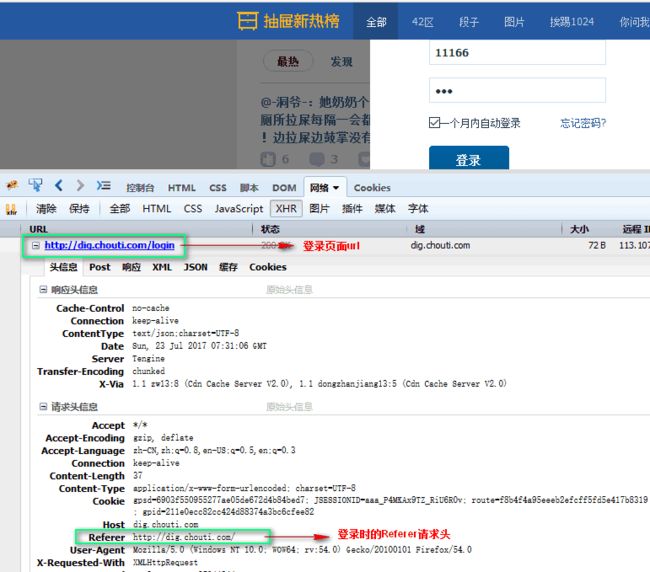requests请求,就是用python的requests模块模拟浏览器请求,返回html源码
模拟浏览器请求有两种,一种是不需要用户登录或者验证的请求,一种是需要用户登录或者验证的请求
一、不需要用户登录或者验证的请求
这种比较简单,直接利用requests模块发一个请求即可拿到html源码
#!/usr/bin/env python
# -*- coding:utf8 -*-
import requests #导入模拟浏览器请求模块
http =requests.get(url="http://www.iqiyi.com/") #发送http请求
http.encoding = "utf-8" #http请求编码
neir = http.text #获取http字符串代码
print(neir)得到html源码
在学习过程中有什么不懂得可以加我的
python学习交流扣扣qun,784758214
群里有不错的学习视频教程、开发工具与电子书籍。
与你分享python企业当下人才需求及怎么从零基础学习好python,和学习什么内容
抽屉新热榜-聚合每日热门、搞笑、有趣资讯
二、需要用户登录或者验证的请求
获取这种页面时,我们首先要了解整个登录过程,一般登录过程是,当用户第一次访问时,会自动在浏览器生成cookie文件,当用户输入登录信息后会携带着生成的cookie文件,如果登录信息正确会给这个cookie
授权,授权后以后访问需要登录的页面时携带授权后cookie即可
1、首先访问一下首页,然后查看是否有自动生成cookie
#!/usr/bin/env python
# -*- coding:utf8 -*-
import requests #导入模拟浏览器请求模块
### 1、在没登录之前访问一下首页,获取cookie
i1 = requests.get(
url="http://dig.chouti.com/",
headers={'Referer': 'http://dig.chouti.com/'}
)
i1.encoding = "utf-8" #http请求编码
i1_cookie = i1.cookies.get_dict()
print(i1_cookie) #返回获取到的cookie
#返回:{'JSESSIONID': 'aaaTztKP-KaGLbX-T6R0v', 'gpsd': 'c227f059746c839a28ab136060fe6ebe', 'route': 'f8b4f4a95eeeb2efcff5fd5e417b8319'}可以看到生成了cookie,说明如果登陆信息正确,后台会给这里的cookie授权,以后访问需要登录的页面携带授权后的cookie即可
2、让程序自动去登录授权cookie
首先我们用浏览器访问登录页面,随便乱输入一下登录密码和账号,获取登录页面url,和登录所需要的字段
携带cookie登录授权
#!/usr/bin/env python
# -*- coding:utf8 -*-
import requests #导入模拟浏览器请求模块
### 1、在没登录之前访问一下首页,获取cookie
i1 = requests.get(
url="http://dig.chouti.com/",
headers={'Referer':'http://dig.chouti.com/'}
)
i1.encoding = "utf-8" #http请求编码
i1_cookie = i1.cookies.get_dict()
print(i1_cookie) #返回获取到的cookie
#返回:{'JSESSIONID': 'aaaTztKP-KaGLbX-T6R0v', 'gpsd': 'c227f059746c839a28ab136060fe6ebe', 'route': 'f8b4f4a95eeeb2efcff5fd5e417b8319'}
### 2、用户登陆,携带上一次的cookie,后台对cookie中的随机字符进行授权
i2 = requests.post(
url="http://dig.chouti.com/login", #登录url
data={ #登录字段
'phone': "8615284816568",
'password': "279819",
'oneMonth': ""
},
headers={'Referer':'http://dig.chouti.com/'},
cookies=i1_cookie #携带cookie
)
i2.encoding = "utf-8"
dluxxi = i2.text
print(dluxxi) #查看登录后服务器的响应
#返回:{"result":{"code":"9999", "message":"", "data":{"complateReg":"0","destJid":"cdu_50072007463"}}} 登录成功3、登录成功后,说明后台已经给cookie授权,这样我们访问需要登录的页面时,携带这个cookie即可,比如获取个人中心
#!/usr/bin/env python
# -*- coding:utf8 -*-
import requests #导入模拟浏览器请求模块
### 1、在没登录之前访问一下首页,获取cookie
i1 = requests.get(
url="http://dig.chouti.com/",
headers={'Referer':'http://dig.chouti.com/'}
)
i1.encoding = "utf-8" #http请求编码
i1_cookie = i1.cookies.get_dict()
print(i1_cookie) #返回获取到的cookie
#返回:{'JSESSIONID': 'aaaTztKP-KaGLbX-T6R0v', 'gpsd': 'c227f059746c839a28ab136060fe6ebe', 'route': 'f8b4f4a95eeeb2efcff5fd5e417b8319'}
### 2、用户登陆,携带上一次的cookie,后台对cookie中的随机字符进行授权
i2 = requests.post(
url="http://dig.chouti.com/login", #登录url
data={ #登录字段
'phone': "8615284816568",
'password': "279819",
'oneMonth': ""
},
headers={'Referer':'http://dig.chouti.com/'},
cookies=i1_cookie #携带cookie
)
i2.encoding = "utf-8"
dluxxi = i2.text
print(dluxxi) #查看登录后服务器的响应
#返回:{"result":{"code":"9999", "message":"", "data":{"complateReg":"0","destJid":"cdu_50072007463"}}} 登录成功
### 3、访问需要登录才能查看的页面,携带着授权后的cookie访问
shouquan_cookie = i1_cookie
i3 = requests.get(
url="http://dig.chouti.com/user/link/saved/1",
headers={'Referer':'http://dig.chouti.com/'},
cookies=shouquan_cookie #携带着授权后的cookie访问
)
i3.encoding = "utf-8"
print(i3.text) #查看需要登录才能查看的页面获取需要登录页面的html源码成功
全部代码
get()方法,发送get请求
encoding属性,设置请求编码
cookies.get_dict()获取cookies
post()发送post请求
text获取服务器响应信息
#!/usr/bin/env python
# -*- coding:utf8 -*-
import requests #导入模拟浏览器请求模块
### 1、在没登录之前访问一下首页,获取cookie
i1 = requests.get(
url="http://dig.chouti.com/",
headers={'Referer':'http://dig.chouti.com/'}
)
i1.encoding = "utf-8" #http请求编码
i1_cookie = i1.cookies.get_dict()
print(i1_cookie) #返回获取到的cookie
#返回:{'JSESSIONID': 'aaaTztKP-KaGLbX-T6R0v', 'gpsd': 'c227f059746c839a28ab136060fe6ebe', 'route': 'f8b4f4a95eeeb2efcff5fd5e417b8319'}
### 2、用户登陆,携带上一次的cookie,后台对cookie中的随机字符进行授权
i2 = requests.post(
url="http://dig.chouti.com/login", #登录url
data={ #登录字段
'phone': "8615284816568",
'password': "279819",
'oneMonth': ""
},
headers={'Referer':'http://dig.chouti.com/'},
cookies=i1_cookie #携带cookie
)
i2.encoding = "utf-8"
dluxxi = i2.text
print(dluxxi) #查看登录后服务器的响应
#返回:{"result":{"code":"9999", "message":"", "data":{"complateReg":"0","destJid":"cdu_50072007463"}}} 登录成功
### 3、访问需要登录才能查看的页面,携带着授权后的cookie访问
shouquan_cookie = i1_cookie
i3 = requests.get(
url="http://dig.chouti.com/user/link/saved/1",
headers={'Referer':'http://dig.chouti.com/'},
cookies=shouquan_cookie #携带着授权后的cookie访问
)
i3.encoding = "utf-8"
print(i3.text) #查看需要登录才能查看的页面如果你依然在编程的世界里迷茫,可以加入我们的Python学习扣qun:784758214,看看前辈们是如何学习的。交流经验。从基础的python脚本到web开发、爬虫、django、数据挖掘等,零基础到项目实战的资料都有整理。送给每一位python的小伙伴!分享一些学习的方法和需要注意的小细节,点击加入我们的 python学习者聚集地
注意:如果登录需要验证码,那就需要做图像处理,根据验证码图片,识别出验证码,将验证码写入登录字段


